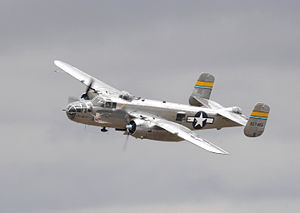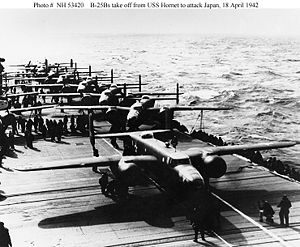Doolittle Raid
Striking Japan on 18 April 1942, the first U.S. offensive operation in the Pacific during the Second World War, the Doolittle Raid, in which 16 B-25 Mitchell medium bombers attacked targets in the Japanese Home Islands, was primarily conceived as a mission to improve morale on the home front. While the actual damage done by the raid was minimal, the operation had a major and negative effect on Japanese strategy, not fully understood until after the end of the war.
Before the Raid, the basic Japanese strategy toward the United States was to hold a defensible perimeter of island bases, and wait for the United States Fleet to move into the Western Pacific, where it would meet the Imperial Japanese Navy on terms unfavorable to the United States. By forcing the combat into territory strongly held by Japan, distant from the U.S., the IJN command hoped to reduce the expected industrial dominance of the U.S.
Admiral Isoroko Yamamoto, commander-in-chief of the Mobile Fleet, had originally, while Navy Vice-Minister, advised against war with the United States. Once the policy decision was made, however, he argued for the Pearl Harbor attack. He believed that if he could cripple the U.S. fleet, he could buy 12-18 months for Japan to consolidate its position. Yamamoto believed that Pearl Harbor was unprepared for an attack, especially in its shallow waters that were believed to prevent the use of air-dropped torpedoes. Ironically, the British, in the 1940 Battle of Taranto, had demonstrated a way to use torpedoes in a shallow harbor.
The operational concept
No carrier-based aircraft of the time had the range to attack Japan from what was considered a safe striking distance. A concept was developed, probably originated by Captain (CAPT) Francis Low of the Navy Staff, to launch U.S. Army medium bombers from a carrier. These bombers could not land on the carrier, but, with special procedures, could take off from one. The plan was that they would land in China after the raid, continuing west after they bombed Japan.
Two aircraft, the B-25 Mitchell and the B-26 Marauder, were available; the B-25 was selected because it needed less distance for takeoff.
U.S. Army Air Force personnel flew the bombers. Lieutenant colonel (LTC) James Doolittle was selected to lead the actual air attack. Vice Admiral William Halsey commanded the overall task force, which included the USS Enterprise (CV-6) providing air and sea defense, and the USS Hornet (CV-8), who carried and launched the Army bombers.
The aircraft were stripped of all possible weight. Where guns had been removed, the turret openings were covered with streamlining metal to reduce drag and improve fuel efficiency.
The raid
While Halsey and Doolittle had agreed to launch the bombers within 400 miles of the Japanese coast, the force was detected early by a Japanese patrol boat. Balancing the risk to the operational carriers of the Pacific Fleet against the optimal attack position, Halsey decided, with Doolittle's agreement, to launch from 650 miles away.
Doolittle's B-25 was the first aircraft to take off. The aircraft were not catapulted; the crew brought the engines to maximum power while holding down the brakes, and then staggered into the air. Each successive aircraft had a bit more takeoff space, but none had the minimum assumed at land bases.
Aftermath: China
Aftermath: Japanese strategy
From 7 December 1941, to 18 April 1942, the Japanese rampaged through the Pacific, defeating American, British, Dutch, and Australian forces. While Yamamoto never suggested that Japan could decisively defeat the United States, he did believe that a negotiated peace, to the advantage of Japan, was possible. The Doolittle raid, however, disrupted Japanese strategic concepts.
Yamamoto, and other senior commanders, felt they had lost face by allowing Tokyo to be bombed and the Emperor threatened. Various Army air defense units were brought back to protect the Home Islands.
The Japanese remained uncertain of the point of origin of the normally land-based B-25 aircraft. Although it would appear outside their maximum range, at least some consideration was given to their somehow having flown from Midway Island. Even if they had not, Yamamoto decided that the Japanese defensive line needed to move eastward, to center on Midway.
So, the Doolittle Raid indirectly led to the Battle of Midway, and a crushing blow to Japanese naval aviation. After 4-8 June 1942, the Japanese were forced into a strategic defensive, from which they never recovered. Shortly before Midway, they had a tactical victory but a strategic defeat at the Battle of the Coral Sea on 4-8 May, 1942, a strategic defeat in that the Japanese did not pursue a planned invasion of New Guinea.

